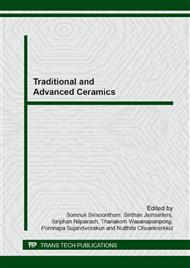p.295
p.301
p.307
p.311
p.316
p.325
p.331
p.335
p.341
Crack Evolution from Ballistic Threats in Laminated Glass
Abstract:
Laminated glass is widely used as safety material and transparent armor. Its typical structure is sandwich layers of glass sheets and Poly Vinyl Butyral (PVB) film. It is known that the ballistic performance of the laminated glass is highly influenced by its configuration. In this study, the damages from ballistic threats at level 3 according to NIJ standard in laminated glass were investigated. Laminated glass with various configurations was fabricated using rolling and vacuum techniques. The ballistic tests were performed and the resulting radial cracks, which intercept several circumferences on each sheet of glass, were quantified. It was found that the number of crack bifurcation and the configurations of laminated glass were significantly correlated. The tested specimens were also cross-sectional observed using water jet cutting machine so that, their ballistic penetration could be determined. The analysis results provide better understanding of crack evolution, leading to improved new transparent armor system.
Info:
Periodical:
Pages:
316-321
Citation:
Online since:
April 2014
Keywords:
Price:
Сopyright:
© 2014 Trans Tech Publications Ltd. All Rights Reserved
Share:
Citation:


